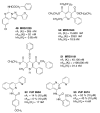Medicinal chemistry of the A3 adenosine receptor: agonists, antagonists, and receptor engineering
- PMID: 19639281
- PMCID: PMC3413728
- DOI: 10.1007/978-3-540-89615-9_5
Medicinal chemistry of the A3 adenosine receptor: agonists, antagonists, and receptor engineering
Abstract
A(3) adenosine receptor (A(3)AR) ligands have been modified to optimize their interaction with the A(3)AR. Most of these modifications have been made to the N(6) and C2 positions of adenine as well as the ribose moiety, and using a combination of these substitutions leads to the most efficacious, selective, and potent ligands. A(3)AR agonists such as IB-MECA and Cl-IB-MECA are now advancing into Phase II clinical trials for treatments targeting diseases such as cancer, arthritis, and psoriasis. Also, a wide number of compounds exerting high potency and selectivity in antagonizing the human (h)A(3)AR have been discovered. These molecules are generally characterized by a notable structural diversity, taking into account that aromatic nitrogen-containing monocyclic (thiazoles and thiadiazoles), bicyclic (isoquinoline, quinozalines, (aza)adenines), tricyclic systems (pyrazoloquinolines, triazoloquinoxalines, pyrazolotriazolopyrimidines, triazolopurines, tricyclic xanthines) and nucleoside derivatives have been identified as potent and selective A(3)AR antagonists. Probably due to the "enigmatic" physiological role of A(3)AR, whose activation may produce opposite effects (for example, concerning tissue protection in inflammatory and cancer cells) and may produce effects that are species dependent, only a few molecules have reached preclinical investigation. Indeed, the most advanced A(3)AR antagonists remain in preclinical testing. Among the antagonists described above, compound OT-7999 is expected to enter clinical trials for the treatment of glaucoma, while several thiazole derivatives are in development as antiallergic, antiasthmatic and/or antiinflammatory drugs.
Figures














Similar articles
-
A3 Adenosine Receptors as Modulators of Inflammation: From Medicinal Chemistry to Therapy.Med Res Rev. 2018 Jul;38(4):1031-1072. doi: 10.1002/med.21456. Epub 2017 Jul 6. Med Res Rev. 2018. PMID: 28682469 Free PMC article. Review.
-
Medicinal chemistry of adenosine A3 receptor ligands.Curr Top Med Chem. 2003;3(4):445-62. doi: 10.2174/1568026033392174. Curr Top Med Chem. 2003. PMID: 12570761 Review.
-
Purine derivatives as ligands for A3 adenosine receptors.Curr Top Med Chem. 2005;5(13):1275-95. doi: 10.2174/156802605774463079. Curr Top Med Chem. 2005. PMID: 16305531 Free PMC article. Review.
-
Selectivity is species-dependent: Characterization of standard agonists and antagonists at human, rat, and mouse adenosine receptors.Purinergic Signal. 2015 Sep;11(3):389-407. doi: 10.1007/s11302-015-9460-9. Epub 2015 Jul 1. Purinergic Signal. 2015. PMID: 26126429 Free PMC article.
-
2-triazole-substituted adenosines: a new class of selective A3 adenosine receptor agonists, partial agonists, and antagonists.J Med Chem. 2006 Dec 14;49(25):7373-83. doi: 10.1021/jm0608208. J Med Chem. 2006. PMID: 17149867 Free PMC article.
Cited by
-
Covalently Binding Adenosine A3 Receptor Agonist ICBM Irreversibly Reduces Voltage-Gated Ca2+ Currents in Dorsal Root Ganglion Neurons.Purinergic Signal. 2024 Feb;20(1):35-45. doi: 10.1007/s11302-023-09929-y. Epub 2023 Mar 15. Purinergic Signal. 2024. PMID: 36918461 Free PMC article.
-
Multivalent dendrimeric and monomeric adenosine agonists attenuate cell death in HL-1 mouse cardiomyocytes expressing the A(3) receptor.Biochem Pharmacol. 2010 Jul 15;80(2):188-96. doi: 10.1016/j.bcp.2010.03.020. Epub 2010 Mar 25. Biochem Pharmacol. 2010. PMID: 20346920 Free PMC article.
-
Exploring Non-orthosteric Interactions with a Series of Potent and Selective A3 Antagonists.ACS Med Chem Lett. 2022 Jan 10;13(2):243-249. doi: 10.1021/acsmedchemlett.1c00598. eCollection 2022 Feb 10. ACS Med Chem Lett. 2022. PMID: 35178181 Free PMC article.
-
G protein-coupled adenosine (P1) and P2Y receptors: ligand design and receptor interactions.Purinergic Signal. 2012 Sep;8(3):419-36. doi: 10.1007/s11302-012-9294-7. Epub 2012 Feb 29. Purinergic Signal. 2012. PMID: 22371149 Free PMC article. Review.
-
Probing structure-activity relationship in β-arrestin2 recruitment of diversely substituted adenosine derivatives.Biochem Pharmacol. 2018 Dec;158:103-113. doi: 10.1016/j.bcp.2018.10.003. Epub 2018 Oct 4. Biochem Pharmacol. 2018. PMID: 30292756 Free PMC article.
References
-
- Baharav E, Bar-Yehuda S, Madi L, Silberman D, Rath-Wolfson L, Halpren M, Ochaion A, Weinberger A, Fishman P. Antiinflammatory effect of A3 adenosine receptor agonists in murine autoimmune arthritis models. J Rheumatol. 2005;32:469–476. - PubMed
-
- Baraldi PG, Cacciari B, de las Infantas MJ Pineda, Romagnoli R, Spalluto G, Volpini R, Costanzi S, Vittori S, Cristalli G, Melman N, Park K-S, Ji X-d, Jacobson KA. Synthesis and biological activity of a new series of N6-arylcarbamoyl-, 2-(ar)alkynyl-N6-arylcarbamoyl, and N6-carboxamido-derivatives of adenosine-5′ -N-ethyluronamide (NECA) as A1 and A3 adenosine receptor agonists. J Med Chem. 1998;41:3174–3185. - PMC - PubMed
-
- Baraldi PG, Cacciari B, Borea PA, Varani K, Pastorin G, Da Ros T, Spalluto G. Pyrazolotriazolo-pyrimidine derivatives as adenosine receptor antagonists: a possible template for adenosine receptor subtypes? Curr Pharm Design. 2002a;8:99–110. - PubMed
-
- Baraldi PG, Cacciari B, Romagnoli R, Spalluto G, Monopoli A, Ongini E, Varani K, Borea PA. 7-Substituted 5-amino-2-(2-furyl)pyrazolo[4,3-e]-1,2,4-triazolo[1,5-c]pyrimidines as A2A adenosine receptor antagonists: a study on the importance of modifications at the side chain on the activity and solubility. J Med Chem. 2002b;45:115–126. - PubMed
-
- Baraldi PG, Tabrizi MA, Fruttarolo F, Bovero A, Avitabile B, Preti D, Romagnoli R, Merighi S, Gessi S, Varani K, Borea PA. Recent developments in the field of A3 adenosine receptor antagonists. Drug Dev Res. 2003a;58:315–329. - PubMed
Publication types
MeSH terms
Substances
Grants and funding
LinkOut - more resources
Full Text Sources
Other Literature Sources
Research Materials
Miscellaneous

